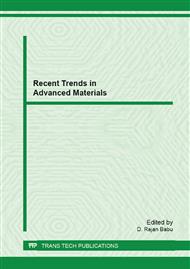p.13
p.18
p.24
p.29
p.33
p.37
p.42
p.47
p.51
Target to Substrate Distance Dependent Optical and Electrical Properties of Sputtered NiO Films
Abstract:
Nickel oxide (NiO) thin films were deposited on glass substrates at various target to substrate distances in the range of 60 to 80 mm by dc reactive magnetron sputtering technique. It was observed that target to substrate distance influenced the morphological, optical and electrical properties of the deposited films. The optical results revealed that the optical transmittance of the films increased with increasing the target to substrate distance upto 70 mm, thereafter it was decreased. The increase in transmittance of the films was due to an increase in size of the grains. The NiO films exhibited an optical transmittance of 60 % and direct band gap of 3.82 eV at target to substrate distance of 70 mm. The films showed high electrical resistivity of 37.3 Ωcm at target to substrate distance of 60 mm and low electrical resistivity of 5.1 Ωcm at target to substrate distance of 70 mm. At high target to substrate distance of 80 mm the electrical resistivity of the film was increased.
Info:
Periodical:
Pages:
33-36
Citation:
Online since:
October 2012
Price:
Сopyright:
© 2012 Trans Tech Publications Ltd. All Rights Reserved
Share:
Citation:


